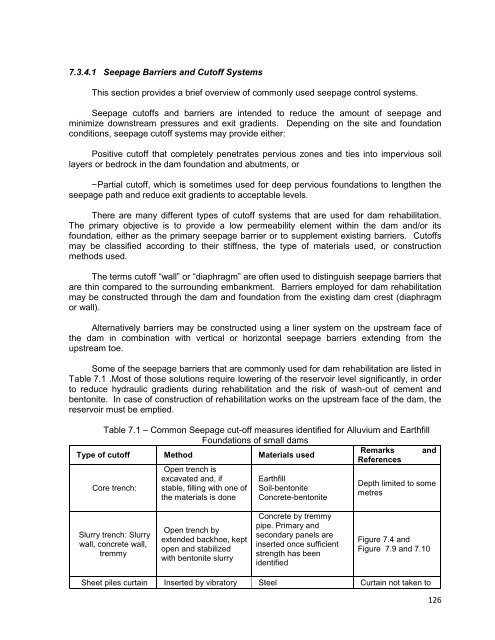SMALL DAMS PETITS BARRAGES
SMALL DAMS PETITS BARRAGES
SMALL DAMS PETITS BARRAGES
- TAGS
- dams
- petits
- barrages
- cbdb.org.br
You also want an ePaper? Increase the reach of your titles
YUMPU automatically turns print PDFs into web optimized ePapers that Google loves.
7.3.4.1 Seepage Barriers and Cutoff Systems<br />
This section provides a brief overview of commonly used seepage control systems.<br />
Seepage cutoffs and barriers are intended to reduce the amount of seepage and<br />
minimize downstream pressures and exit gradients. Depending on the site and foundation<br />
conditions, seepage cutoff systems may provide either:<br />
Positive cutoff that completely penetrates pervious zones and ties into impervious soil<br />
layers or bedrock in the dam foundation and abutments, or<br />
− Partial cutoff, which is sometimes used for deep pervious foundations to lengthen the<br />
seepage path and reduce exit gradients to acceptable levels.<br />
There are many different types of cutoff systems that are used for dam rehabilitation.<br />
The primary objective is to provide a low permeability element within the dam and/or its<br />
foundation, either as the primary seepage barrier or to supplement existing barriers. Cutoffs<br />
may be classified according to their stiffness, the type of materials used, or construction<br />
methods used.<br />
The terms cutoff “wall” or “diaphragm” are often used to distinguish seepage barriers that<br />
are thin compared to the surrounding embankment. Barriers employed for dam rehabilitation<br />
may be constructed through the dam and foundation from the existing dam crest (diaphragm<br />
or wall).<br />
Alternatively barriers may be constructed using a liner system on the upstream face of<br />
the dam in combination with vertical or horizontal seepage barriers extending from the<br />
upstream toe.<br />
Some of the seepage barriers that are commonly used for dam rehabilitation are listed in<br />
Table 7.1 .Most of those solutions require lowering of the reservoir level significantly, in order<br />
to reduce hydraulic gradients during rehabilitation and the risk of wash-out of cement and<br />
bentonite. In case of construction of rehabilitation works on the upstream face of the dam, the<br />
reservoir must be emptied.<br />
Table 7.1 – Common Seepage cut-off measures identified for Alluvium and Earthfill<br />
Foundations of small dams<br />
Type of cutoff Method<br />
Open trench is<br />
Materials used<br />
Remarks<br />
References<br />
and<br />
Core trench:<br />
excavated and, if<br />
stable, filling with one of<br />
the materials is done<br />
Earthfill<br />
Soil-bentonite<br />
Concrete-bentonite<br />
Depth limited to some<br />
metres<br />
Slurry trench: Slurry<br />
wall, concrete wall,<br />
tremmy<br />
Open trench by<br />
extended backhoe, kept<br />
open and stabilized<br />
with bentonite slurry<br />
Concrete by tremmy<br />
pipe. Primary and<br />
secondary panels are<br />
inserted once sufficient<br />
strength has been<br />
identified<br />
Figure 7.4 and<br />
Figure 7.9 and 7.10<br />
Sheet piles curtain Inserted by vibratory Steel Curtain not taken to<br />
126














